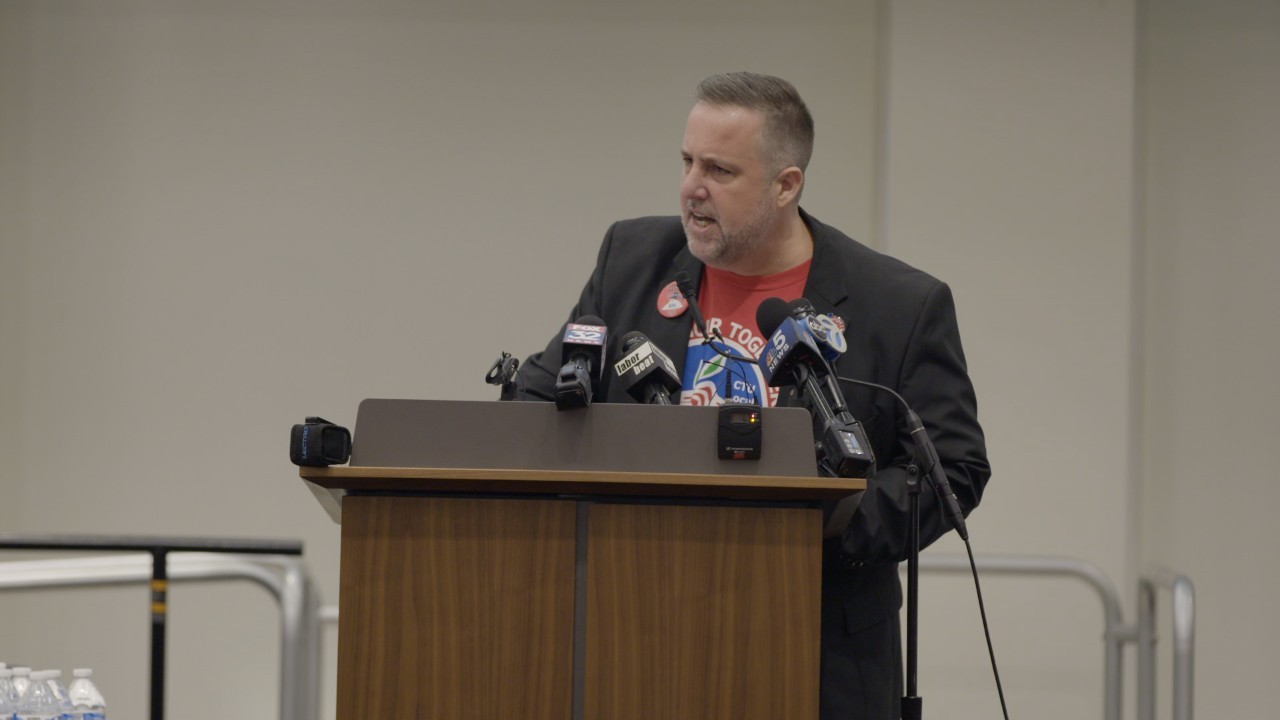Photos by the author and social image via by Robyn Beck / AFP / Getty
For the five- and six year-old students busily penning letters to their teachers Tuesday morning, the second day of the Los Angeles teachers strike was much like any other would have been at Dahlia Heights Elementary. Kristine Henderson, who said she typically specialized in kids with hearing loss at various district schools, worked from a lesson plan other educators prepared before they hit the picket line, passing out worksheets they’d printed for her mixed-age classes to use.“Why don’t you write about what you did yesterday in school?” Henderson encouraged her pupils.
“This is not school!” challenged her six-year-old son CJ Stanback.
“No, this is strike school!” the teacher laughed back. The students whooped in approval.

Henderson is one of the more than 30,000 teachers who went on strike Monday, the first day of the first teacher’s strike to hit the city in 30 years, after negotiations over class size, support staff, and teacher pay between the massive Los Angeles Unified School District and the powerful union United Teachers Los Angeles stalled. She is also one of a small but growing number of parents organizing ad-hoc educational cooperatives to help working families keep their kids out of class—that is, supporting the strike—but still learning through the action.“I’m a stay-at-home mom, so I thought one way we could support the teachers was to keep the kids home,” said Jenna Wagner, a mother of four who opened her house in the Eagle Rock neighborhood of northeastern Los Angeles to about 20 students and a rotating “staff” of parent volunteers from her children’s elementary school. “Not everybody has the same choices that we have.” Roughly 500,000 students attend LAUSD schools and many working parents have no choice but to send their children in despite the labor dispute—even if they want to support to the strikers. Of course, that assumes students have a stable home or live with their parents at all."In Watts, 35 percent of students are in foster care," said local educator Amreen Karmali, cofounder of the radical teachers of color collective the People’s Education Movement. District-wide, as many as 21,000 students are homeless.Indeed, strike-school mom Lindsey Clough said she and other hosts were cautioned that they would need to provide food to students who may get their only meal from the district. And it's worth noting that strike school classrooms did not appear to reflect the district's overwhelmingly Latino demographic breakdown. Although Henderson is black and many of her son's Dahlia Heights classmates Latino and Asian-American, the majority of LAUSD students look little like the mostly white ones who studied together at Wagner's house on Tuesday.But early numbers suggested many thousands of students from all backgrounds—perhaps even two-thirds—were staying home, many presumably doing so in solidarity with teachers. Parents told me 40 of Dahlia Heights' roughly 400 students attended school on Monday, while Tuesday saw just 42. (Officials declined to answer specific attendance questions, instead emailing a link to the LAUSD homepage, but across the district, only about 141,000 students were estimated to be in their classrooms. That number was said to tick up on Tuesday.)“A lot of people are just trying to make a statement and not sending their kids to school—if they can,” Henderson emphasized while she watched CJ and the other strike-school boys shoot hoops during a brief break in the rain. “For us, this is awesome.”Crossing the picket line is particularly fraught in Los Angeles, where both progressive values and organized labor abound. But the cost of living is so high that few can afford to miss a shift to look after kids.“A lot of families here are in the film industry, and those unions are the reason we have health insurance,” mom Allison Turner told me, referring to some who did send their kids to strike school. “The future of unions is uncertain with the Supreme Court and everything—we wanted to support families that support the strike but both parents had to work.”Teachers at Dahlia Heights Elementary School spent the days before the strike filling a Google Drive with schedules, lesson plans and even materials organized by grade to keep students occupied and learning through the dispute, which some fear could drag on for two weeks or more.Meanwhile, similar collectives were cropping up across the city, particularly in gentrifying neighborhoods like Eagle Rock, where date palms dot the hillside and film industry families rub elbows with federal workers.“It’s a community that you don’t think you can have in a city this big,” said Clough, who hosted another strike school a few blocks away. “Especially in public school, you’re dealing with such a breadth of socioeconomic situations. That’s why this fight is so important.”In addition to a 6.5 percent immediate, retroactive pay increase, the union had demanded more nurses, librarians and counselors in schools, and sharper limits on class size. Teachers wanted the number of students per classroom capped, and in some cases reduced, but the latest District offer to trim about two students per middle-school class, among other changes—albeit only guaranteed for a year—didn't cut it.“Los Angeles Unified did not want a strike and offered UTLA leaders a $565 million package to significantly reduce class sizes, add nearly 1,200 educators in schools, and provide all UTLA members with 6 percent salary raises,” the district wrote on its website Monday. “Los Angeles Unified remains committed to contract negotiations and will continue to work around the clock to find solutions to end the strike which will hurt students, families and communities most in need throughout Los Angeles.”But teachers said they couldn't accept the terms they were offered.“For me, it’s class size and the fact we don’t have nurses in every school,” said PE teacher and LAUSD mom Sherlett Newbill, 46, who braved the rain to picket outside Dorsey High School in southwest LA Monday afternoon. “I was a student here 30 years ago, I remember my teachers being out on strike. This fight is no different.”“It’s just bananas to think you can give a student a decent valid education with 47 kids in a class,” agreed Karmali. “I’m getting teary about this because teachers work their fucking asses off.”For Henderson, the prospect of a protracted negotiation was particularly nerve wracking. She and CJ’s father both saved for the strike, she said, but not for the government shutdown, which she said left him—a Department of Homeland Security supervisor—without a paycheck even as he reported to work every day at Los Angeles International Airport.“We were prepared for it to take however long it takes,” she said of the strike, but losing two checks at once has taken an unexpected toll. CJ knows she’s on strike, but not necessarily what it means. “We took him to the picket line to see his teacher, but he’s not really aware of what's going on.While CJ and his friends frolic in the sunshine and gorge themselves on snacks from Trader Joe’s, their peers in classrooms across the district were often stuck in front of TV sets, doing busy work or shuttling between all-grade auditoriums, several teachers and parents said. Clough said she walked into her son Charlie’s kindergarten classroom Monday afternoon en route to an independent after-school program on campus to find the children watching a movie.But, for parents like her with little or no background in education, running a classroom may be more work than they bargained for.“We’re two adults to three kids and by the end of the day, we were so exhausted,” Clough confessed of her first day of strike school on Monday. “Teachers should get whatever they want.”Still, she and other strike school parents said they would keep going whether the dispute lasts for two weeks or two months.“Obviously, we don’t want our kids out of school for that long,” Wagner told me, flitting between the kindergarten class on the first floor of her home and the mixed second- and third-grade on the second, her three-month-old sleeping cradled to her chest. “But we can do it for as long as we need to.”Sign up for our newsletter to get the best of VICE delivered to your inbox daily.Follow Sonja Sharp on Twitter.
Advertisement

Henderson is one of the more than 30,000 teachers who went on strike Monday, the first day of the first teacher’s strike to hit the city in 30 years, after negotiations over class size, support staff, and teacher pay between the massive Los Angeles Unified School District and the powerful union United Teachers Los Angeles stalled. She is also one of a small but growing number of parents organizing ad-hoc educational cooperatives to help working families keep their kids out of class—that is, supporting the strike—but still learning through the action.“I’m a stay-at-home mom, so I thought one way we could support the teachers was to keep the kids home,” said Jenna Wagner, a mother of four who opened her house in the Eagle Rock neighborhood of northeastern Los Angeles to about 20 students and a rotating “staff” of parent volunteers from her children’s elementary school. “Not everybody has the same choices that we have.” Roughly 500,000 students attend LAUSD schools and many working parents have no choice but to send their children in despite the labor dispute—even if they want to support to the strikers. Of course, that assumes students have a stable home or live with their parents at all.
Advertisement
Advertisement
Advertisement
Advertisement
